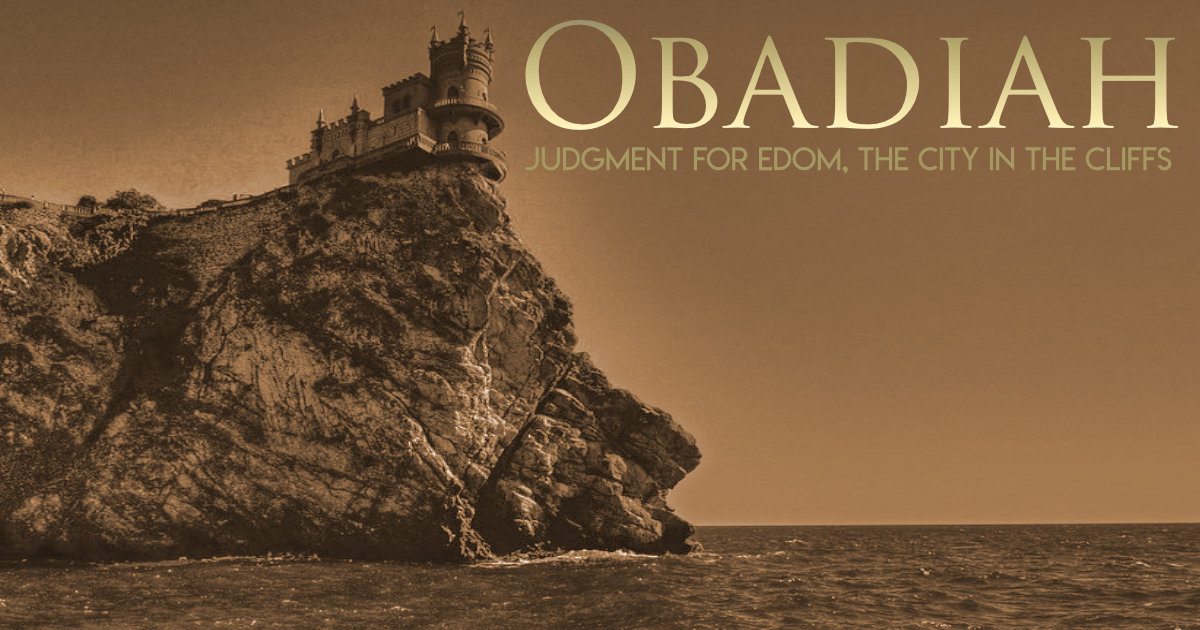 Authorship
Authorship
It is very difficult to know which Obadiah wrote this book, because “the name, which means ‘servant of Yahweh,’ is given to at least twelve other OT characters, none of whom seem obviously to be the author named in the book.”[1] Jeremiah 49 and Obadiah show a striking similarity to one another (Obad. 1-5; Jer. 49:9, 14-16). Who borrowed from whom? This is difficult to discern.
Date
This is the shortest book in the OT, which makes it difficult to date. Some place it as early as the ninth century (under Jehoram) or as late as the sixth century (after the destruction of Jerusalem). Luther placed it in the sixth century, but Archer writes, “A good majority of the evangelical scholars of the nineteenth and early twentieth centuries have inclined toward a much earlier date, that of Jehoram ben Jehoshaphat, 848-841.”[2] It must have been written at least by the sixth century, because Edom was destroyed by then (Mal. 1:3-4; Ezek. 32:29).
History of Edom
Edom existed at least as far back as the time of Joseph (~1,800 BC; Gen. 36), and it existed near Mount Seir. David had conquered Edom in his day, but they must have rebelled and become a sovereign kingdom later (594 BC; Jer. 27:3; 40:11).[3]
Summary of Obadiah
The focus of the book is the destruction of Edom (v.1). The city of Edom was embedded in a mountain fortress, which seemed impenetrable. But in the seventh century AD, Edom was conquered by Muslim warriors (AD 636). Today, it is a place for tourists. It has never been rebuilt.[4] Obadiah gives this prophecy to Edom, because Jerusalem’s destruction is imminent. He warns them not to overdo Jerusalem’s judgment, or God will bring the same to them.
Commentary on Obadiah
Unless otherwise stated, all citations are taken from the New American Standard Bible (NASB).
(1:1) The “we” refers to the prophetic community or the people of Israel in general.
The “envoy” (ṣîr) refers to an ambassador who was visiting the different nations, inciting them against Edom.[5]
This opening verse shows a relationship between God’s sovereignty behind Edom’s destruction, as well as the human responsibility of the nations who carried out the judgment.
(1:2) By making Edom “small,” God is showing that he is going to judge this nation.
(1:3-4) The city was wedged into the rocks 4,000 to 5,700 feet in the air,[6] so it was virtually impossible for invaders to conquer them. Edom taunts the nations, “Who will bring me down to the earth?” (v.3) God replies, “Me!” (“I will bring you down,” v.4)
(1:5-6) Even thieves leave something behind (usually by accident or out of haste), but God is going to completely obliterate Edom.
(1:7) Even Edom’s allies will betray them.
(1:8) The people of Edom thought that they were wise, but in reality, they were deceived.
(1:9) “Teman” refers to “the northern sector of Edom, though it is identified by some scholars as a city on the site of modern Tawilan, near Petra.”[7]
(1:10) The reason why the Edomites were being judged was because of their “violence” (ḥāmās), and they were judged for gloating over Israel’s destruction (Ps. 137:7; Lam. 4:21-22; Ezek. 25:12; 35:5, 15; 36:5; Joel 3:19).
The judgment against Edom would be “forever.”
(1:11) When the foreigners came and sacked Jerusalem, the Edomites were like these enemies (“You too were one of them”).
(1:12-14) The Edomites had boasted and rejoiced when Israel/Judah suffered.
(1:15) The judgment of God was drawing “near” for the people. They would be judged based on what they did to others.
(1:16) The “drinking” seems to imply that they are spiritually deceived and “drunk,” so to speak.
(1:17-18) The people of Judah will escape God’s judgment, but not the people of Edom. The judgment is compared to a “fire” that leaves Edom in “stubble.”
(1:19-20) The exiles of Judah would take over this land in Edom.
(1:21) The day is coming when everyone will be able to see God’s “kingdom” on Earth.
[1] Armerding, C. E. Obadiah. In F. E. Gaebelein (Ed.), The Expositor’s Bible Commentary: Daniel and the Minor Prophets (Vol. 7). Grand Rapids, MI: Zondervan Publishing House. 1986. 337.
[2] Archer, Gleason. A Survey of Old Testament Introduction (3rd. ed.). Chicago: Moody Press. 1994. 333.
[3] Armerding, C. E. (1986). Obadiah. In F. E. Gaebelein (Ed.), The Expositor’s Bible Commentary: Daniel and the Minor Prophets (Vol. 7, p. 335). Grand Rapids, MI: Zondervan Publishing House.
[4] Geisler, Norman L. Baker Encyclopedia of Christian Apologetics. Grand Rapids, MI: Baker, 1999. 613.
[5] Armerding, C. E. (1986). Obadiah. In F. E. Gaebelein (Ed.), The Expositor’s Bible Commentary: Daniel and the Minor Prophets (Vol. 7, p. 341). Grand Rapids, MI: Zondervan Publishing House.
[6] Armerding, C. E. (1986). Obadiah. In F. E. Gaebelein (Ed.), The Expositor’s Bible Commentary: Daniel and the Minor Prophets (Vol. 7, pp. 342-343). Grand Rapids, MI: Zondervan Publishing House.
[7] Armerding, C. E. (1986). Obadiah. In F. E. Gaebelein (Ed.), The Expositor’s Bible Commentary: Daniel and the Minor Prophets (Vol. 7, p. 347). Grand Rapids, MI: Zondervan Publishing House.
